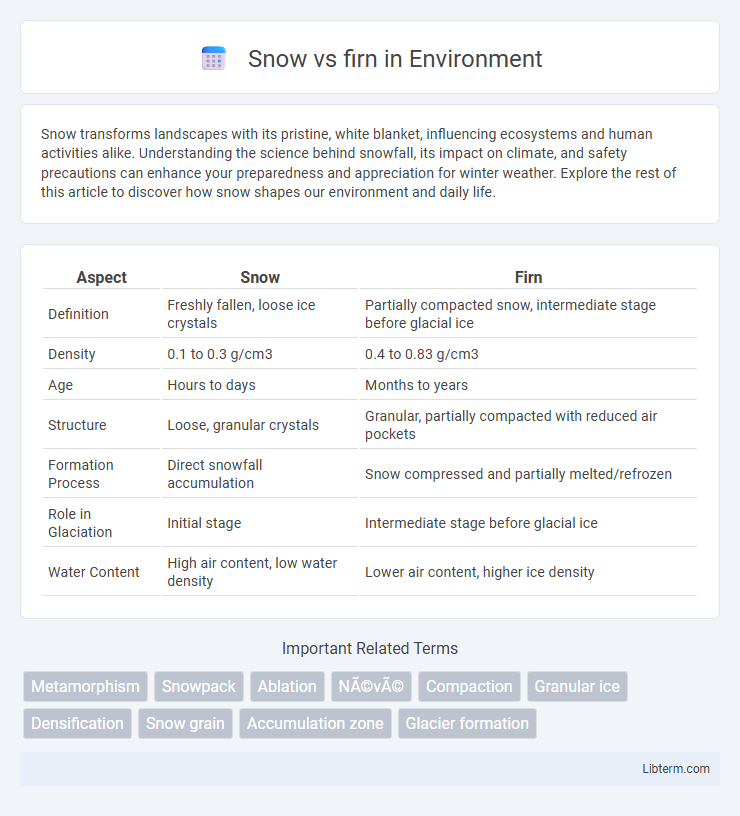Snow transforms landscapes with its pristine, white blanket, influencing ecosystems and human activities alike. Understanding the science behind snowfall, its impact on climate, and safety precautions can enhance your preparedness and appreciation for winter weather. Explore the rest of this article to discover how snow shapes our environment and daily life.
Table of Comparison
| Aspect | Snow | Firn |
|---|---|---|
| Definition | Freshly fallen, loose ice crystals | Partially compacted snow, intermediate stage before glacial ice |
| Density | 0.1 to 0.3 g/cm3 | 0.4 to 0.83 g/cm3 |
| Age | Hours to days | Months to years |
| Structure | Loose, granular crystals | Granular, partially compacted with reduced air pockets |
| Formation Process | Direct snowfall accumulation | Snow compressed and partially melted/refrozen |
| Role in Glaciation | Initial stage | Intermediate stage before glacial ice |
| Water Content | High air content, low water density | Lower air content, higher ice density |
Definition of Snow and Firn
Snow consists of fresh, crystalline ice particles that have recently fallen and exhibit a light, fluffy texture with high air content. Firn is compacted snow that has survived one or more melt seasons, undergoing partial melting and refreezing, resulting in a denser, granular form intermediate between snow and glacial ice. The transformation from snow to firn involves progressive compaction and recrystallization, which reduces porosity and increases density.
Formation Processes of Snow and Firn
Snow forms from the condensation of water vapor in cold air, resulting in ice crystals that aggregate and fall to the ground as fresh snowfall. Firn develops when snow persists through multiple melt and refreeze cycles, compacting and recrystallizing over time into a denser, granular form that is intermediate between snow and glacial ice. The transformation from snow to firn involves processes such as sintering, where ice grains bond and expel air, increasing density and leading to firnification in polar and high-altitude environments.
Physical Characteristics Comparison
Snow consists of fresh ice crystals with a fluffy, granular structure and low density typically around 0.1 g/cm3, while firn is compacted snow that has undergone partial melting and refreezing, increasing its density to approximately 0.4 to 0.8 g/cm3. Snowflakes exhibit intricate, branched crystal shapes, whereas firn grains are more rounded and tightly packed, contributing to its firmer texture. The transformation from snow to firn involves a reduction in air content and increased grain bonding, resulting in a denser, more resilient material crucial in glacier formation.
Temperature and Climate Influence
Snow transforms into firn through a gradual process influenced primarily by temperature and climate conditions. Cold climates with consistent below-freezing temperatures slow the melting and compaction of snow, allowing it to recrystallize into firn over time. Warmer or variable climates accelerate melting and reduce firn formation, affecting glacial mass balance and the albedo effect.
Density Differences
Snow typically has a density ranging from 50 to 200 kilograms per cubic meter, characterized by a loose, fluffy structure with numerous air pockets. Firn, as an intermediate stage between snow and glacial ice, exhibits higher density values around 400 to 830 kilograms per cubic meter due to compression and partial melting that reduces air space. The density increase from snow to firn reflects the gradual expulsion of air and recrystallization processes that enhance the material's compactness and durability.
Importance in Glacier Formation
Snow transforms into firn through compaction and recrystallization, marking a crucial phase in glacier formation. Firn, denser and more granular than snow, gradually compresses under pressure to become glacial ice, enabling glacier growth and movement. Understanding the snow-to-firn transition provides key insights into glacier mass balance and climate change impacts.
Longevity and Transformation Stages
Snow consists of freshly fallen ice crystals with a short lifespan, typically transitioning into firn within weeks to years under pressure and partial melting. Firn represents an intermediate metamorphic stage between snow and glacial ice, characterized by increased density and grain size, persisting for decades to centuries before further compaction. The transformation from snow to firn marks critical stages in glaciology, impacting glacier formation and long-term ice sheet stability.
Environmental Impact
Snow and firn influence environmental dynamics through their roles in the cryosphere and hydrological cycles. Snow, consisting of freshly fallen ice crystals, has higher albedo, reflecting significant solar radiation and contributing to surface cooling, while firn, older and denser snow partially compacted, impacts glacier mass balance by serving as a transitional stage between snow and glacial ice. The transformation from snow to firn affects water storage, runoff patterns, and carbon sequestration, influencing ecosystem stability and global climate feedback mechanisms.
Role in Water Storage and Hydrology
Snow acts as a critical seasonal water reservoir by accumulating on the surface and gradually melting to sustain rivers and groundwater recharge. Firn, being older, compacted snow that has begun the transformation into glacial ice, stores water longer and influences long-term hydrological cycles by slowly releasing meltwater. The transition from snow to firn stabilizes mountain water supply, mitigating flood risks and supporting ecosystems during dry periods.
Key Scientific Research on Snow and Firn
Key scientific research on snow and firn explores their distinct physical properties, such as density and grain size, which influence climate models and glaciological studies. Studies utilize ice core analysis and remote sensing to understand firn's role in carbon dioxide trapping and meltwater percolation, crucial for predicting sea level rise. Advanced techniques in spectroscopy and isotopic measurements provide insights into environmental changes recorded in firn layers over time.
Snow Infographic

 libterm.com
libterm.com